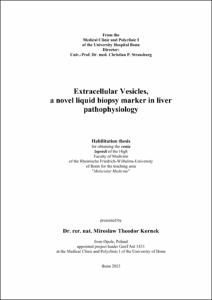Kornek, Miroslaw Theodor: Extracellular Vesicles, a novel liquid biopsy marker in liver pathophysiology. - Bonn, 2023. - Habilitation, Rheinische Friedrich-Wilhelms-Universität Bonn.
Online-Ausgabe in bonndoc: https://nbn-resolving.org/urn:nbn:de:hbz:5-71566
Online-Ausgabe in bonndoc: https://nbn-resolving.org/urn:nbn:de:hbz:5-71566
@phdthesis{handle:20.500.11811/10951,
urn: https://nbn-resolving.org/urn:nbn:de:hbz:5-71566,
author = {{Miroslaw Theodor Kornek}},
title = {Extracellular Vesicles, a novel liquid biopsy marker in liver pathophysiology},
school = {Rheinische Friedrich-Wilhelms-Universität Bonn},
year = 2023,
month = jul,
note = {This habilitation thesis is actually spanning more than a decade of successful and high-profile laboratory research published accordingly in high cited journals as Hepatology, Gastroenterology and Journal of Hepatology. During more than a decade, 2008-2021, the developments in EV science are actually well reflected by our publication track record, e.g. as applying correct wording for investigated EV populations in accordance with EV mainstream understanding at that timepoint. Framing lEVs as microparticles by us during first few years at Harvard Medical School, probably raising unintentionally an idea of microparticles being non-organic particles. Later developments encouraged us to use the more correct term of microvesicles. Microvesicles had been correctly associated with vesicles that are typically organic origin. However, micro still did not and does not imply the correct nano-size nature of microvesicles, but, somehow still correctly emphasizing that microvesicles are overall very little in size. Pursuing standardization in our EV research field, 2018, my lab contributed to the publication of the revised MISEV guidelines, which uniformly called these entities microparticles/microvesicles. Additoinally, we distinguished between large extracellular vesicles (lEVs) separating them from small extracellular vesicles (sEVs, commonly referred as exosomes). This standardization approach to name EVs correctly took more than a decade, as this habilitation thesis did. However, from more importance was the research content during this decade presented in this work. Among them was how lEVs were used as a tool to profile HCV, later even to differentiate HCV from NAFLD. Moreover, lEVs were regarded as a pan-cancer biomarker tool and finally were used to screen liver cancers in valuable collectives being at risk to develop liver cancer. And recently our work revived Alpha-fetoprotein (AFP) as a biomarker in order to distinguish HCC from CCA including iCCA and exCCA with a pinpoint accuracy of 100% sensitivity and 100% specificity. Actually, this habilitation thesis shows the development of an idea that was born at BIDMC, Harvard Medical School and which was completed in Bonn, Germany.},
url = {https://hdl.handle.net/20.500.11811/10951}
}
urn: https://nbn-resolving.org/urn:nbn:de:hbz:5-71566,
author = {{Miroslaw Theodor Kornek}},
title = {Extracellular Vesicles, a novel liquid biopsy marker in liver pathophysiology},
school = {Rheinische Friedrich-Wilhelms-Universität Bonn},
year = 2023,
month = jul,
note = {This habilitation thesis is actually spanning more than a decade of successful and high-profile laboratory research published accordingly in high cited journals as Hepatology, Gastroenterology and Journal of Hepatology. During more than a decade, 2008-2021, the developments in EV science are actually well reflected by our publication track record, e.g. as applying correct wording for investigated EV populations in accordance with EV mainstream understanding at that timepoint. Framing lEVs as microparticles by us during first few years at Harvard Medical School, probably raising unintentionally an idea of microparticles being non-organic particles. Later developments encouraged us to use the more correct term of microvesicles. Microvesicles had been correctly associated with vesicles that are typically organic origin. However, micro still did not and does not imply the correct nano-size nature of microvesicles, but, somehow still correctly emphasizing that microvesicles are overall very little in size. Pursuing standardization in our EV research field, 2018, my lab contributed to the publication of the revised MISEV guidelines, which uniformly called these entities microparticles/microvesicles. Additoinally, we distinguished between large extracellular vesicles (lEVs) separating them from small extracellular vesicles (sEVs, commonly referred as exosomes). This standardization approach to name EVs correctly took more than a decade, as this habilitation thesis did. However, from more importance was the research content during this decade presented in this work. Among them was how lEVs were used as a tool to profile HCV, later even to differentiate HCV from NAFLD. Moreover, lEVs were regarded as a pan-cancer biomarker tool and finally were used to screen liver cancers in valuable collectives being at risk to develop liver cancer. And recently our work revived Alpha-fetoprotein (AFP) as a biomarker in order to distinguish HCC from CCA including iCCA and exCCA with a pinpoint accuracy of 100% sensitivity and 100% specificity. Actually, this habilitation thesis shows the development of an idea that was born at BIDMC, Harvard Medical School and which was completed in Bonn, Germany.},
url = {https://hdl.handle.net/20.500.11811/10951}
}






